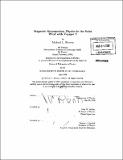Magnetic reconnection physics in the solar wind with Voyager 2
Author(s)
Stevens, M. L. (MIchael Louis)
DownloadFull printable version (35.61Mb)
Other Contributors
Massachusetts Institute of Technology. Dept. of Physics.
Advisor
John W. Belcher.
Terms of use
Metadata
Show full item recordAbstract
Magnetic reconnection is the process by which the magnetic topology evolves in collisionless plasmas. This phenomenon is fundamental to a broad range of astrophysical processes such as stellar flares, magnetospheric substorms, and plasma accretion, yet it is poorly understood and difficult to observe in situ. In this thesis, the solar wind plasma permeating interplanetary space is treated as a laboratory for reconnection physics. I present an exhaustive statistical approach to the identification of reconnection outflow jets in turbulent plasma and magnetic field time series data. This approach has been automated and characterized so that the resulting reconnection survey can be put in context with other related studies. The algorithm is shown to perform similarly to ad hoc studies in the inner heliosphere. Based on this technique, I present a survey of 138 outflow jets for the Voyager 2 spacecraft mission, including the most distant in situ evidence of reconnection discovered to date. Reconnection in the solar wind is shown to be strongly correlated with stream interactions and with solar activity. The solar wind magnetic field is found to be reconnecting via large, quasi-steady slow-mode magnetohydrodynamic structures as far out as the orbit of Neptune. The role of slow-mode shocks is explored and, in one instance, a well-developed reconnection structure is shown to be in good agreement with the Petschek theory for fast reconnection. This is the first reported example of a reconnection exhaust that satisfies the full jump conditions for a stationary slow-mode shock pair. (cont.) A complete investigation into corotating stream interactions over the Voyager 2 mission has revealed that detectable reconnection structure occurs in about 23% of forced, global-scale current sheets. Contrary to previous studies, I find that signatures of this kind are most likely to be observed for current sheets where the magnetic field shear and the plasma-[beta] are high. Evidence has been found of thinning in Kelvin-Helmholtz unstable reconnection structures. I hypothesize that reconnection in turbulent environments occurs predominantly on smaller scales than one can measure with Voyager 2.
Description
Thesis (Ph. D.)--Massachusetts Institute of Technology, Dept. of Physics, 2009. Cataloged from PDF version of thesis. Includes bibliographical references (p. 112-120).
Date issued
2009Department
Massachusetts Institute of Technology. Department of PhysicsPublisher
Massachusetts Institute of Technology
Keywords
Physics.